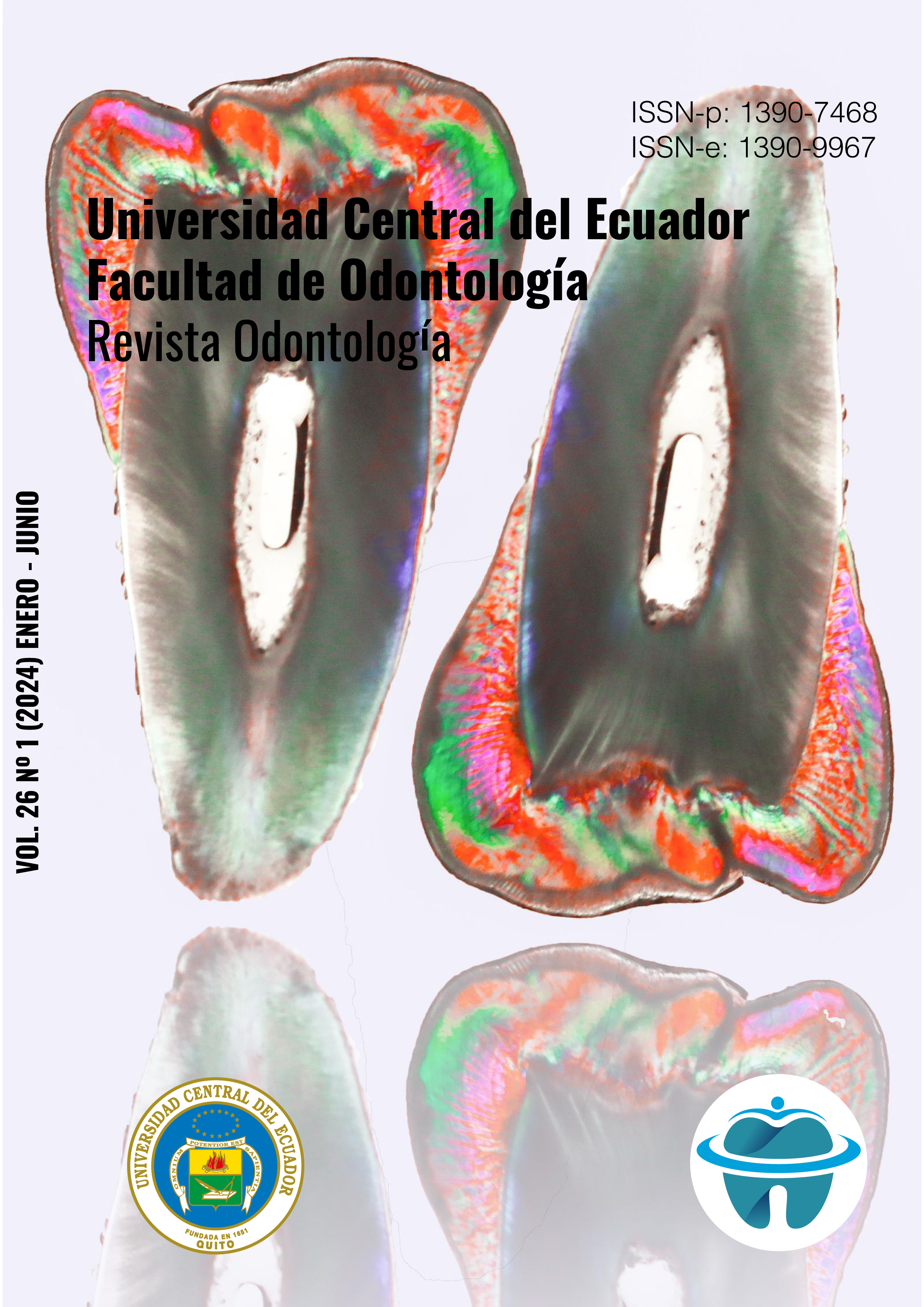Determine the exact length of the veneers through programming the condylar inclination of the semi-adjustable articulator
DOI:
https://doi.org/10.29166/odontologia.vol26.n1.2024-e5789Palabras clave:
semi-adjustable, fracture or breakdown, condylar inclinationResumen
Purpose: Various aspects of veneers have been described in literature, such as preparation, material, manufacturing method, bonding technique, remaining dental structure color, among others. The length of veneers incisal edge, that has been determined through photos or videos doing a functional evaluation, creating an anterior guide by mockup in addition to the diagnostic elements mentioned above, the veneers were exactly length based on the condyle inclination.
Materials and methods: The technique shown in the following clinical case report, aims to customize the length of the veneers by programming the condylar inclination and the incisal plate of the semi-adjustable articulator. Results: The veneers made with the present technique was accurately. Conclusion: Customize the length of the veneers demonstrated avoid wear, fracture or breakdown of the bond.
Descargas
Citas
Danielle M Layton, Michael Clarke. A systematic review and meta-analysis of the survival of non-feldspathic porcelain veneers over 5 and 10 years. Int J Prosthodont. 2013;26:111-24.
Susana Morimoto, Rafael Borges Albanesi, Newton Sesma, Carlos Martins Agra, Mariana Minatel Braga. Main Clinical Outcomes of Feldspathic Porcelain and Glass-Ceramic Laminate Veneers: A Systematic Review and Meta-Analysis of Survival and Complication Rates. Int J Prosthodont. 2016;29:38-49.
FriedmanMJ.A15year review of porcelain veneer failure: aclinician’s observations.Com- pend Contin Educ Dent. 1998;19:625–36.
Christian Coachman, Galip Gurel, Marcelo Calamita, Susana Morimoto, Braulio Paolucci, Newton Sesma.The influence of tooth color on preparation design for laminate veneers from a minimally invasive perspective: case report. Int J Periodontics Restorative Dent. 2014;34:453-9.
LeSage B. Establishing a classification system and criteria for veneer preparations. Compend Contin Educ Dent 2013;34:104–112.
H Dumfahrt. Porcelain laminate veneers. A retrospective evaluation after 1 to 10 years of service: Part I--Clinical procedure. Int J Prosthodont. 1999;12:505-13.
Ines Filipa alves de Varvalho Tiago Miguel Santos Marques, Filipe Miguel Araújo, Luís Filipe Azevedo, Helena Donato, André Correia. Clinical Performance of CAD/CAM Tooth-Supported Ceramic Restorations: A Systematic Review. Int J Periodontics Restorative Dent. 2018;38:e68-e78.
John R Calamia, Christine S Calamia. Porcelain laminate veneers: reasons for 25 years of success. Dent Clin North Am. 2007;51:399-417
Fabio A P Rizzante, Idiane B L Soares-Rusu, Suellen S Senna, Carla M Ramos-Tonello, Rafael F L Mondelli, Sérgio K Ishikiriama, Ana Flávia S Borges, Zvi Gutmacher. Flexural strength of minimum thickness ceramic veneers manufactured with different techniques. Quintessence Int. 2020;51:268-273
Wei-Shao Lin, Carlo Ercoli, Changyong Feng, Dean Morton . The effect of core material, veneering porcelain, and fabrication technique on the biaxial flexural strength and weibull analysis of selected dental ceramics. J Prosthodont. 2012;21:353-62.
P Magne, R Perroud, J S Hodges, U C Belser. Clinical performance of novel-design porcelain veneers for the recovery of coronal volume and length. Int J Periodontics Restorative Dent. 2000;20:440-57.
P Magne, W H Douglas. Design optimization and evolution of bonded ceramics for the anterior dentition: a finite-element analysis. Quintessence Int.1999;30:661-72.
P Magne, A Versluis, W H Douglas. Rationalization of incisor shape: experimental-numerical analysis. J Prosthet Dent. 1999;81:345-55.
Daniel Edelhoff, Otto Prandtner, Reza Saeidi Pour, Anja Liebermann, Michael Stimmelmayr, Jan-Frederik Güth. Anterior restorations: The performance of ceramic veneers. Quintessence Int. 2018;49:89-101.
Galip Gürel. Porcelain laminate veneers: minimal tooth preparation by design. Dent Clin North Am. 2007;51:419-31
S Hobo, H Takayama. A new system for measuring condylar path and computing anterior guidance: Part I. Measuring principle. Int J Prosthodont. 1988;1:99-106.
Prasad D, Shah N, Hegde C. A clinico-radiographic analysis of sagittal condylar guidance determined by protrusive interocclusal registration and panoramic radiographic images in humans. Contemporary clinical dentistry. 2012;3:383-7.
Publicado
Cómo citar
Número
Sección
Licencia
Derechos de autor 2024 Juan Del Valle Lovato, Jorge Balcazar

Esta obra está bajo una licencia internacional Creative Commons Atribución-NoComercial-SinDerivadas 4.0.


